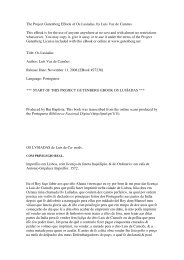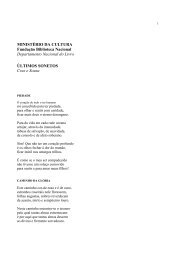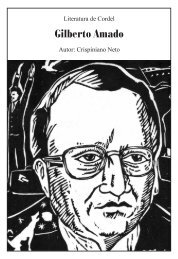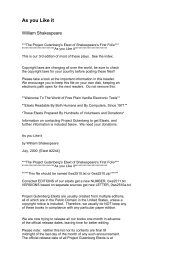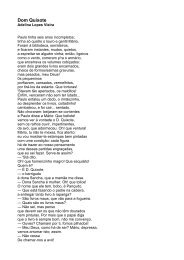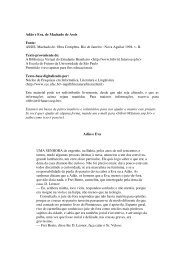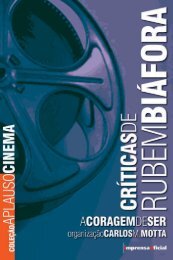You also want an ePaper? Increase the reach of your titles
YUMPU automatically turns print PDFs into web optimized ePapers that Google loves.
Moreover, inaccurate as Hugo often is, it is never the inaccuracy that falsifies. He has<br />
been severely criticized for having in Au Lion d'Androclès assigned to a single epoch<br />
events and personages which are really separated by centuries. But all the facts are<br />
typical of the spirit which dominated Imperial Rome, and combine therefore to form a<br />
<strong>des</strong>cription which has poetic and imaginative, if not historical, truth. And if, with<br />
greater licence, he has accumu<strong>la</strong>ted upon the head of a single Mourad all the crimes of a<br />
long line of Sultans it is because in drawing Mourad he is drawing the Turkish nation.<br />
Mourad is to him the typical Turk, the embodiment of Oriental cruelty and lust. If again,<br />
to pass to a <strong>la</strong>rger subject, he has chosen legend rather than history as the basis of many<br />
of his poems, it is not only because of his own innate love of the marvellous and<br />
romantic, but because he cared for the truth embodied in legend more than the truth<br />
embodied in chronicle. If he mingled fiction with his history, it was because he<br />
conceived of the fiction as being as true a representation of the facts of an era as annals<br />
and records. It may be true that Hugo made imagination do duty for study, but it is also<br />
true that an imagination, such as Hugo's, may be as sure an instrument as study in<br />
reconstructing the past. He may have mistaken the date of Crassus by several centuries,<br />
but readers of Suetonius will hardly deny the faithfulness of his delineation of at least<br />
one side of the civilization of ancient Rome; he may have invented a Spanish princess,<br />
but his carefully stippled portrait of Philip II is true to the life, even if it be Philip in his<br />
darkest moods. His inaccuracies are in truth of small account. Who that reads Le<br />
Cimetière d'Ey<strong>la</strong>u cares whether there was a p<strong>la</strong>ce of burial in the battlefield or not? or<br />
what lover of Booz endormi seeks to know how closely the flora of Palestine has been<br />
studied? A more serious criticism than the charge of inaccuracy is that of partial vision,<br />
and from this Hugo cannot be entirely exculpated. He saw with his heart, and seeing<br />
with the heart must always mean partial vision. For at the root of Hugo's nature <strong>la</strong>y an<br />
immense pity, pity not merely for the suffering, but for what is base or criminal, or what<br />
is ugly or degraded. It was this pity which is the keynote of Notre-Dame de Paris and<br />
Les Misérables; it is this pity which inspired much of the Légende <strong>des</strong> Siècles.<br />
The defence of the weak by the strong is one of his constant themes, as witness<br />
Éviradnus, Le Petit Roi de Galice, Les Pauvres Gens. The contrast of the weak and the<br />
strong is one of his favourite artistic effects, as witness Booz endormi, La Confiance du<br />
Marquis Falrice. An act of pity redeemed Sultan Mourad, an act of pity made the poor<br />
ass greater than all the philosophers. It was this absorbing pity for the defenceless that<br />
made Hugo so merciless to the oppressor and so incapable of seeing anything but the<br />
deepest b<strong>la</strong>ck in the picture of the tyrant. One-sided the poet may be, but it is the onesidedness<br />
of a generous nature; he may err, but his errors at least lean to the side of<br />
virtue.<br />
It would be impossible in the brief space of an introduction such as this to discuss at any<br />
length the characteristics of Hugo as a literary artist, but a few remarks may be made on<br />
some of the features of his art which are most conspicuous in the poems selected for this<br />
volume. It is scarcely necessary to dwell upon the poet's extraordinary fecundity of<br />
words and images. Occasionally, especially in his <strong>la</strong>ter works, this degenerates into<br />
diffuseness, and he exhibits a tendency to repetition and a fondness for long<br />
enumeration of names and details. On the other hand, he constantly shows how well he<br />
understood the power of brevity and compression. There is not a superfluous word nor a<br />
poetic image in La Conscience, the severe and simple style of which is well suited to the<br />
sternness of the subject. The story of Après <strong>la</strong> Bataille is re<strong>la</strong>ted with telling<br />
conciseness, while in the highly finished work of Booz endormi there are no redundant




